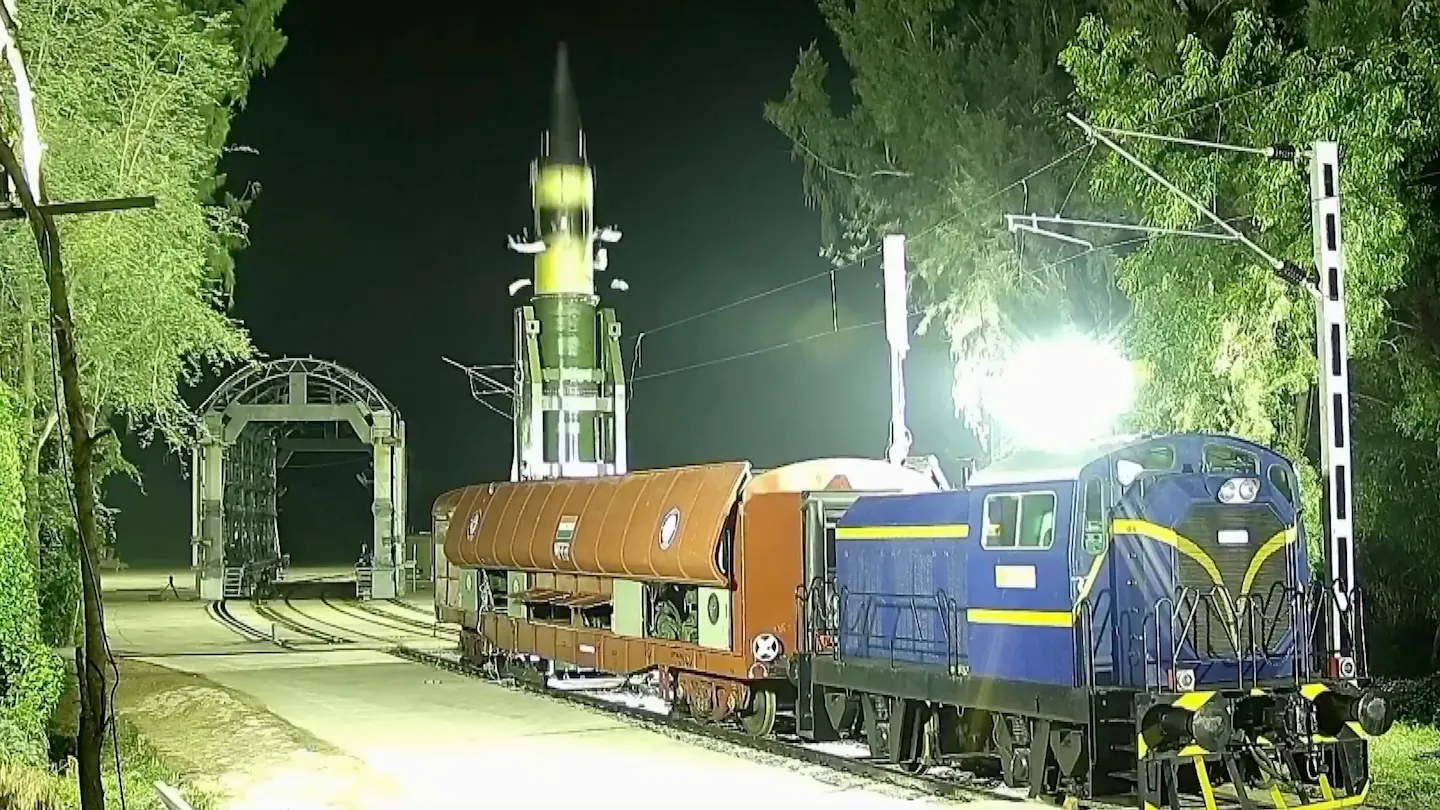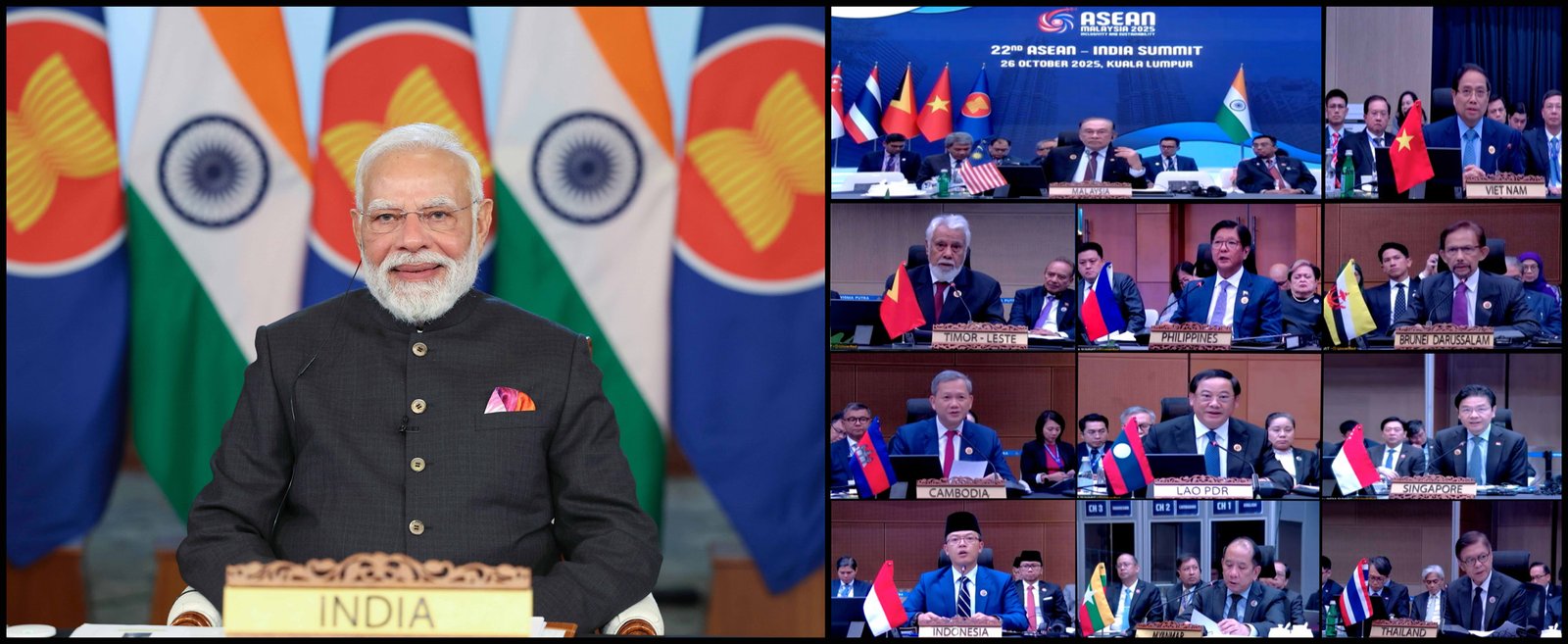Why in the News?
- The Defence Research and Development Organisation (DRDO) successfully test-fired the Agni-Prime (Agni-P) missile from a rail-based mobile launcher.
- This makes India one of the few countries (Russia, US, China, and possibly North Korea) with the ability to launch long-range ballistic missiles from rail platforms.
- The test significantly boosts India’s credible nuclear deterrence and strengthens its second-strike capability under the No First Use (NFU) doctrine.
Key Highlights
- About Agni-P Missile
- A medium-range ballistic missile (MRBM) with a range of 1,000–2,000 km.
- Two-stage, solid-fuel propelled, weighing around 11,000 kg.
- Capable of carrying nuclear, thermobaric, or high-explosive warheads.
- Incorporates advanced navigation and propulsion systems derived from Agni-IV and Agni-V.
- Significance of Rail-Based Launch Platforms
- Mobility advantage: Utilises India’s 70,000 km rail network, enabling deployment across the country.
- Stealth: Tunnels and underpasses help hide launchers from satellite surveillance.
- Cost efficiency: Cheaper to maintain compared to submarine- launched ballistic missile (SLBM)
- Second-Strike Capability and NFU Policy
- India follows a No First Use doctrine, requiring survivable and assured second-strike capacity.
- Rail-based systems improve survivability by reducing dependence on vulnerable silos.
- Enhances deterrence credibility against adversaries like China and Pakistan.
- Global Context
- Only Russia, USA, China, and possibly North Korea had such capability before.
- India’s induction places it in a strategic elite group, enhancing its nuclear deterrence posture.
- Historical Context of Agni Series
- Agni-I (700–1,000 km) tested in 1989, marking India’s entry into ballistic missile capability.
- Agni-II, III, IV, and V gradually extended range up to 5,000 km+.
- Agni-P serves as an upgrade to Agni-I, providing better accuracy, mobility, and survivability.
| No First Use (NFU) Doctrine 1. The No First Use doctrine is India’s official nuclear policy, which states that India will never use nuclear weapons first in any conflict. 2. Nuclear weapons will only be used in retaliation if India is attacked with them. 3. This policy helps reduce the risk of sudden nuclear wars and presents India as a responsible nuclear power in the international community. 4. To make NFU effective, India must always maintain a reliable second-strike capability. Second-Strike Capability 1. Second-strike capability means that even if India is attacked with nuclear weapons first, it will still be able to retaliate with its own nuclear weapons. 2. This ensures that no country dares to launch a first strike, because they know they will face destruction in return. 3. In India’s case, this is crucial to make its No First Use policy credible. 4. Such capability is achieved by keeping some nuclear missiles safe and hidden on submarines, mobile road launchers, or now, rail-based systems. |
Implications
- Strategic Deterrence
- Strengthens India’s credible minimum deterrence
- Enhances survivability of nuclear assets against a first strike.
- Geopolitical Impact
- Signals to China and Pakistan that India can deploy nuclear assets flexibly.
- Raises India’s profile in global strategic balance.
- Military Modernisation
- Demonstrates indigenous defence technology development.
- Reduces reliance on vulnerable road-based systems.
- Cost-Effective Security
- Rail-based deployment offers an affordable alternative to submarine fleets.
- Allows scaling up of deterrence with fewer financial constraints.
- Boost to Defence R&D
- Enhances DRDO’s credibility and technological expertise.
- Opens pathways for future innovations in mobile launch systems.
Challenges and Way Forward
| Challenges | Way Forward |
| Satellite surveillance by adversaries makes movement detectable. | Invest in camouflage, technologies, deception and electronic countermeasures. |
| Rail network vulnerabilities during wartime (targeting by enemy). | Strengthen railway security protocols and redundancy routes. |
| Logistical dependence on railways may limit flexibility. | Develop integrated road–rail–sea–air mobility mix. |
| Technological race with China and Pakistan. | Continuous upgradation of missile guidance, stealth, and survivability. |
| High financial costs despite being cheaper than submarines. | Prioritise cost-effective R&D and public–private partnerships in defence. |
Conclusion
The successful rail-based test of Agni-P marks a strategic milestone in India’s nuclear doctrine. It strengthens India’s second-strike capability, ensures deterrence credibility, and signals India’s entry into a select global club of advanced nuclear powers. With rail-based systems, India combines mobility, stealth, and cost-effectiveness, aligning military modernisation with national security goals.
| Ensure IAS Mains Question Q. Discuss the significance of India’s rail-based missile launch capability in the context of its nuclear doctrine and second-strike capability. How does it alter India’s strategic deterrence posture? (250 words) |
| Ensure IAS Prelims Question Q. Consider the following statements about Agni-P missile: 1. It is a two-stage, solid-fuel propelled missile with a range of 1,000–2,000 km. 2. It is capable of being launched from road, rail, and submarine platforms. 3. It is an upgrade of Agni-I, incorporating features from Agni-IV and Agni-V. 4. India is the first country to deploy a rail-based ballistic missile system. Which of the above statements are correct? a) 1 and 3 only b) 1, 2 and 3 only c) 2 and 4 only d) 1, 3 and 4 only Answer: a) 1 and 3 only Explanation: Statement 1 is correct: The Agni-P missile is indeed a two-stage, solid-fuel propelled ballistic missile with a range of 1,000–2,000 km. Solid-fuel propulsion allows for quick launch readiness and easier storage compared to liquid-fuel missiles, which require fueling before launch. Statement 2 is incorrect: While Agni-P can be launched from road-mobile and rail-mobile platforms, it is not designed for submarine launch. Submarine-launched ballistic missiles (SLBMs) require entirely different launch technology and integration with submarines, which Agni-P does not have. Statement 3 is correct: Agni-P is considered an upgrade of the earlier Agni-I missile, combining its range with advanced propulsion, guidance, and navigation technologies borrowed from Agni-IV and Agni-V missiles. This improves accuracy, mobility, and survivability, making it more suitable for modern strategic requirements. Statement 4 is incorrect: India is not the first country to deploy a rail-based ballistic missile system. Before India, countries like Russia, the USA, China, and possibly North Korea had already developed this capability. India’s achievement lies in joining this select group, rather than being the pioneer. |
Also Read | |
| UPSC Foundation Course | UPSC Daily Current Affairs |
| UPSC Monthly Magazine | CSAT Foundation Course |
| Free MCQs for UPSC Prelims | UPSC Test Series |
| ENSURE IAS NOTES | Our Booklist |





